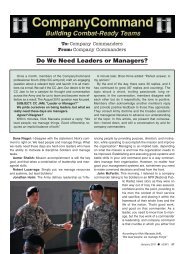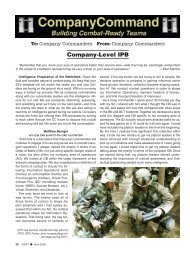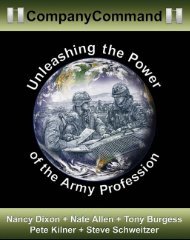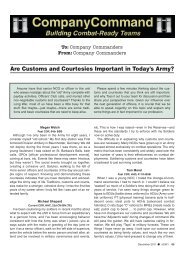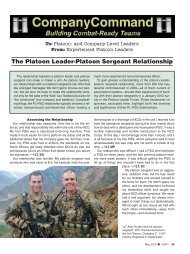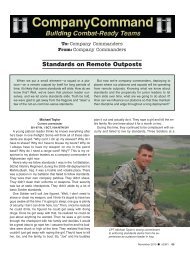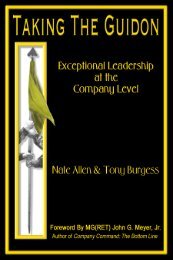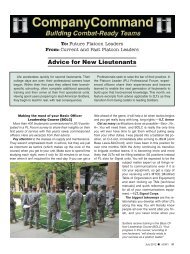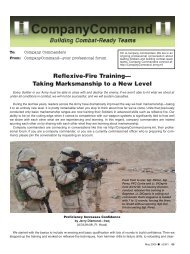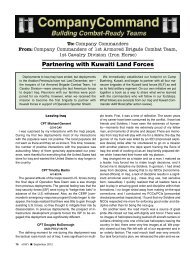Afghan Cdr AAR Book - Company Command - U.S. Army
Afghan Cdr AAR Book - Company Command - U.S. Army
Afghan Cdr AAR Book - Company Command - U.S. Army
You also want an ePaper? Increase the reach of your titles
YUMPU automatically turns print PDFs into web optimized ePapers that Google loves.
<strong>Afghan</strong> <strong>Command</strong>er<br />
<strong>AAR</strong> <strong>Book</strong><br />
(OEF-7)<br />
Preparing<br />
for the<br />
experience<br />
In the<br />
Experience<br />
Coming out<br />
of the<br />
experience
<strong>Afghan</strong> <strong>Cdr</strong> <strong>AAR</strong> <strong>Book</strong><br />
This book is by and for company commanders; it brings<br />
together commanders who have experience leading in<br />
<strong>Afghan</strong>istan with commanders who are preparing for<br />
combat operations in <strong>Afghan</strong>istan right now.<br />
All rights reserved.<br />
This is a <strong>Company</strong><strong>Command</strong>.army.mil forum product; it is by and for<br />
company commanders and is published by the U.S. <strong>Army</strong>’s Center for<br />
<strong>Company</strong>-level Leaders (CCL) at the United States Military Academy, West<br />
Point, NY—in partnership with the 3 rd Brigade, 10 th Mountain Division.<br />
POC: LTC Tony Burgess (tony.burgess@us.army.mil).<br />
First Edition, March 2007
Introduction<br />
This book is by-and-for company commanders; it brings together commanders who have<br />
experience leading in <strong>Afghan</strong>istan with commanders who are preparing for combat operations in<br />
<strong>Afghan</strong>istan right now.<br />
We believe that “the cutting-edge knowledge of the <strong>Army</strong> resides in the minds of leaders at the tip of the<br />
spear. Connecting these leaders in conversation brings together the <strong>Army</strong>’s greatest knowledge<br />
resources, unleashing the power of the <strong>Army</strong> profession to improve combat effectiveness.” 1<br />
In these pages, the company commanders of Task Force Spartan (3 rd Brigade, 10 th Mountain Division)<br />
have gathered with you to share their hard-earned knowledge—knowledge borne of sweat and blood,<br />
forged in the rugged and sometimes ruthless mountains, valleys, and plains of <strong>Afghan</strong>istan. They know<br />
better than anyone right now how your preparation can and will make the difference between life and<br />
death, between success and failure. They want to serve you and make a difference for you. They are in it<br />
with you!<br />
The book is organized into three main parts:<br />
PART 1: Themes and Highlights<br />
PART 2: TF Spartan <strong>Company</strong> <strong>Command</strong>er Insights<br />
There is no substitute for experience!<br />
We can more effectively prepare for<br />
that experience by connecting with<br />
those who have already done what<br />
we are preparing to do.<br />
PART 3: Past <strong>Afghan</strong> <strong>Command</strong>er Insights<br />
Our desire is that this book serves as a catalyst for your preparation and makes a positive difference for<br />
you and your team as you prepare for combat operations. In addition to reading what your comrades<br />
share on these pages, we encourage you to contact the contributors directly—to carry on the conversation<br />
that they have begun. Think of this <strong>AAR</strong> book as the beginning of an ongoing conversation between<br />
professionals who are committed to improving our effectiveness and advancing our profession.<br />
It is our privilege to present this book to you. May God bless you now and in the months ahead.<br />
Fight Fiercely!<br />
Your <strong>Company</strong><strong>Command</strong> Team<br />
Building Combat-Ready Teams!<br />
1 Dixon, et al., <strong>Company</strong> <strong>Command</strong>: Unleashing the Power of the <strong>Army</strong> Profession (2005). This is the story of the CC forum.
<strong>Afghan</strong> <strong>Command</strong>er <strong>AAR</strong> <strong>Book</strong>, OEF-7<br />
“WITH YOUR SHIELD<br />
OR ON IT”<br />
“I will tell His Majesty what a king is. A king does not abide within his tent while his<br />
men bleed and die upon the field. A king does not dine while his men go hungry, nor<br />
sleep when they stand at watch upon the wall. A king does not command his men's<br />
loyalty through fear nor purchase it with gold; he earns their love by the sweat of his own<br />
back and the pains he endures for their sake. That which comprises the harshest burden,<br />
a king lifts first and sets down last. A king does not require service of those he leads but<br />
provides it to them. He serves them, not they him."<br />
—Steven Pressfield, Gates of Fire: p. 412<br />
2<br />
http://afghancommander.army.mil
<strong>Afghan</strong> <strong>Command</strong>er <strong>AAR</strong> <strong>Book</strong>, OEF-7<br />
Foreword<br />
by Colonel John Nicholson (<strong>Command</strong>er, TF Spartan)<br />
In any war, especially a counterinsurgency, company commanders perform the most challenging and<br />
critical duties on the battlefield, their decisions influencing small-unit actions as well as operational and<br />
even strategic outcomes. Given the dispersion of forces required to conduct the COIN campaign in<br />
Regional <strong>Command</strong> East, <strong>Afghan</strong>istan, the role of the company commander in TF Spartan is perhaps even<br />
more critical to success than in other theaters or operations. Our company commanders must not only<br />
possess the requisite skills to expertly conduct combined-arms operations to defeat the enemy; they must<br />
also be capable of achieving unity of effort with many diverse joint, interagency and multinational actors<br />
in achieving effects with the population in their area. Many of these entities were previously only<br />
present at higher echelons, meaning most commanders possess little, if any, experience working with<br />
them. Frequently, there is no overall unity of command, requiring the commander to become adept at<br />
identifying common interests and potential friction points, accentuating the former and mitigating the<br />
latter. <strong>Company</strong> <strong>Command</strong>ers must be able to seamlessly transition between lethal and non-lethal<br />
operations, establish relationships with district governors, village elders, <strong>Afghan</strong> National Security Forces<br />
(ANSF) leaders, and other local nationals, all the while dealing with centuries-old, complex tribal and<br />
cultural dynamics. Finally, they must be capable of operating autonomously in remote, Spartan outposts<br />
guided by their own intuition, commander’s intent, and the experience and advice of their NCOs and<br />
junior leaders. The execution of all of these responsibilities is further challenged by <strong>Afghan</strong>istan’s poor<br />
infrastructure, unpredictable weather, and rugged terrain, and their effects on warfighting functions,<br />
notably logistics, mobility, aviation, and communications.<br />
The overarching TF Spartan strategy during OEF-VII has been to: (1) separate the enemy from the<br />
population, (2) achieve effects with the population through their government and (3) transform the<br />
environment both tangibly and intangibly so that the enemy is no longer welcome. This strategy can only<br />
be effectively implemented when both US and <strong>Afghan</strong> forces live amongst the population. TF Spartan<br />
recognized this and nearly tripled its footprint by establishing company and platoon-sized outposts across<br />
the area of operations, selecting locations important in terms of both the physical and human terrain.<br />
When combined US and <strong>Afghan</strong> security elements move into an area and stay, it radically changes the<br />
dynamics of the environment. Presence enables relationships with the population, develops their<br />
confidence in their own government and security forces and places continuous pressure on the enemy.<br />
While a population-focused strategy relies heavily on non-kinetic means, it increases kinetic operations as<br />
well. “Planting the flag” in the heart of known enemy sanctuaries dislocates the enemy both physically<br />
and psychologically. He must fight back or lose. TF Spartan experienced a sharp rise in combat over<br />
previous rotations, but thanks to the close combat skill and firepower of American units, killed<br />
exponentially more enemy than suffered friendly casualties. The metric of enemy dead is not useful in<br />
gauging COIN success, but it does provide insight into the degree to which a unit has separated the enemy<br />
from the populace. Killing, capturing, forcing to flee or convincing the enemy to reconcile are all ways to<br />
achieve separation. This is a continuous process, but once begun, it buys space and time for the company<br />
commander and his leaders to achieve effects with the populace. By integrating ANSF at every<br />
opportunity, connecting the people to their government, and setting the conditions for economic<br />
development though road-building and other projects, the population is convinced that their best hope for<br />
a brighter future lies with the IRoA. If the enemy attempts to regain influence, they return to find a<br />
transformed environment that is no longer hospitable for them. This transformation does not occur<br />
overnight, but rather through months and often years of determination, relationship-building, economic<br />
development, and IRoA capacity-building.<br />
3<br />
http://afghancommander.army.mil
<strong>Afghan</strong> <strong>Command</strong>er <strong>AAR</strong> <strong>Book</strong>, OEF-7<br />
This strategy depends upon effective leadership at the leading edge—with our squads, platoons, and<br />
companies. Our company-level commanders are, across the board, exceptional—and so it is with great<br />
enthusiasm that I introduce this book, which captures their insights so well. I invite all company-level<br />
leaders, especially those of you preparing to deploy in the near future to <strong>Afghan</strong>istan, to invest your time<br />
generously in reading, studying, and discussing the insights of these leaders—commanders who have<br />
spent the last 14+ months immersed in fighting a challenging and complex counterinsurgency. It is<br />
essential that we advance the state of the art in <strong>Afghan</strong>istan with a common visualization of the way<br />
ahead, even as units and leaders rotate in and out. My intent is that this book contributes to a shared<br />
vision by transferring the hard-earned knowledge and experience achieved by Spartan company<br />
commanders to future <strong>Afghan</strong>istan company commanders. The target audience of this book is not only<br />
company leaders; it should be read by battalion, brigade, and even division and joint-task-force-level<br />
commanders and staff officers so that they may gain better situational understanding and perspective from<br />
the company commander on the ground in RC-East.<br />
As you will find echoed throughout this book, both the terrain and weather are unforgiving, and they<br />
influence operations as much as the enemy does. A leadership challenge company commanders will face<br />
is balancing tactical and accidental risk—especially when it comes to operating in the difficult terrain and<br />
weather, to include driving heavy up-armored vehicles on dangerous unimproved roads. Moving slowly<br />
and deliberately, after conditions have been set, typically gets you to your objective quicker and with the<br />
combat power to fight. Taking shortcuts and unnecessary risks typically slows you down and/or<br />
compromises your Soldiers’ safety or provides the enemy the opportunity to effectively engage you. The<br />
enemy is tough, has been fighting for generations, and should not be underestimated. However, even the<br />
most determined enemy is no match for well-trained, educated, led, and equipped US maneuver<br />
companies and platoons. To successfully operate in the rugged, mountainous terrain of RC-East, precious<br />
training time should be focused on: (1) physical fitness (and mental toughness), with emphasis on foot<br />
marching over difficult terrain with heavy loads; (2) marksmanship, especially long-range marksmanship<br />
utilizing all weapon systems and optics; (3) first responder medical training and casualty evacuation; (4)<br />
employment of fires, to include call for fire and CCA integration; and (5) small unit drills to include both<br />
mounted and dismounted drills.<br />
When it comes to preparing your Soldiers for the human/cultural dimension of this operation, the greatest<br />
thing that you can do is educate yourself and your leaders and instill genuine respect for the <strong>Afghan</strong><br />
people. You have heard the adage, “every Soldier a sensor”; it is also true that every Soldier is an<br />
ambassador. Given that the population is the center of gravity to this operation, ensuring cultural<br />
awareness is critical to success. The lives of <strong>Afghan</strong> people are hard and short—life expectancy is 43;<br />
one in five children die by age five; 16% of mothers die in childbirth; 80% illiteracy; 60%<br />
unemployment; public health situation is worse than a country with an AIDS epidemic—yet the <strong>Afghan</strong><br />
people are generous, pious, hospitable and genuinely appreciate our presence in their country. While<br />
important for leaders to work hard to establish relationships with local governmental leaders and elders, it<br />
is even better if Soldiers are positively reinforcing this connection every time that they interact with<br />
people. For example, drivers should operate smartly yet safely on the roads, Soldiers should treat local<br />
nationals working on the FOB with respect, and junior leaders should seek to develop trust and<br />
confidence in the <strong>Afghan</strong> Security Forces with whom they train and operate. We should ask ourselves the<br />
question, “Is what I’m doing (the way I’m treating this person) moving them closer to or further away<br />
from supporting coalition forces and the <strong>Afghan</strong> Government” A unit that understands this will achieve<br />
powerful results, while a unit that does not will find it difficult to accomplish the mission.<br />
The fight here is decentralized, with young Soldiers and their NCOs and officers making important<br />
decisions with strategic consequences every day. It is therefore important to provide as many<br />
opportunities as possible for leaders to lead and to make tough decisions before they deploy. Focusing<br />
4<br />
http://afghancommander.army.mil
<strong>Afghan</strong> <strong>Command</strong>er <strong>AAR</strong> <strong>Book</strong>, OEF-7<br />
your training at the lowest levels and using vignettes or simulations to provide junior leaders additional<br />
opportunities to exercise tactical decision-making in situations they will likely face on the ground will<br />
help. The discussion about what-would-you-do scenarios also serves as a catalyst for leaders to gain<br />
shared understanding and insights into how the team members think. For example: “PFC Jones is on an<br />
OP and observes 3 individuals vicinity a historical POO site. He is too far away to make out details, but<br />
he is convinced one of them has a weapon. Do you have PID (positive identification) What are the<br />
potential consequences if you call in fires and they are not enemy What are the consequences if they are<br />
enemy and you do not engage them”<br />
Because the fight is so decentralized, a leader cannot know everything, even if they had previous<br />
experience in <strong>Afghan</strong>istan or read every book on the excellent recommended reading list on page 15. Be<br />
humble and recognize that rank alone is not a determinant of intellect, an ability to recognize<br />
opportunities, or an ability to develop innovative solutions. Involve your subordinates and teammates on<br />
the battlefield as much as possible in the planning process and seek out their ideas and their analysis of<br />
the situation. Create and utilize a battle command system that enables you to tap into the collective<br />
genius resident in your unit—figure out how you will leverage the creativity, energy, insights and<br />
understanding of all of your subordinates. If you do so, you will be rewarded with mission success and<br />
greater unit cohesion, essential in this challenging environment.<br />
I am extremely proud of the company commanders that you will meet in this book. They have learned<br />
and continue to learn a great deal about counterinsurgency operations and have invested much into their<br />
mission. Their collective insights provide a comprehensive view of what it takes to lead Soldiers and<br />
accomplish the mission in <strong>Afghan</strong>istan. Hopefully, this book will provide those who read it a better<br />
understanding about RC-East and enable them to better prepare their Soldiers for operations here. Future<br />
company commanders can build upon what we have done and take RC-East and the <strong>Afghan</strong> Government<br />
to the next level, another step closer to developing the capacity to effectively secure and govern its own<br />
nation and deny terrorist organizations safe haven. With your shield, or on it!<br />
John W. Nicholson Jr.<br />
30 March 2007<br />
Jalalabad Air Field, <strong>Afghan</strong>istan<br />
5<br />
http://afghancommander.army.mil
<strong>Afghan</strong> <strong>Command</strong>er <strong>AAR</strong> <strong>Book</strong>, OEF-7<br />
About the <strong>Afghan</strong> <strong>Command</strong>er <strong>AAR</strong> Project, by LTC Tony Burgess<br />
This book is by and for company commanders; it brings together commanders who have<br />
experience leading in <strong>Afghan</strong>istan with commanders who are preparing to deploy there right now.<br />
This book is the result of a partnership between the <strong>Company</strong> <strong>Command</strong> (CC) forum and TF Spartan<br />
(formed around the 3 rd Brigade Combat Team, 10 th Mountain Division). It has been a complete team<br />
effort. I contacted Colonel Nicholson, the TF Spartan <strong>Command</strong>er, in October 2006 with a proposal that<br />
we help capture the learning of his company commanders in <strong>Afghan</strong>istan. The concept fit into a<br />
comprehensive review that he and his team were already undergoing; he endorsed the project and his<br />
point man, Major Atherton, stepped up to the plate to help shape the project and facilitate our connection<br />
to the company commanders.<br />
The project has occurred in four major phases: (1) Written survey (see Appendix C) developed and<br />
completed by TF Spartan company commanders primarily during December 2006; (2) <strong>Command</strong>er <strong>AAR</strong><br />
narratives (Part 2 of this book) crafted from the survey input, primarily during December 2006 and<br />
January 2007; (3) Video interviews with the contributors “on location” in <strong>Afghan</strong>istan during January and<br />
February 2007; and (4) completion of this book, with emphasis on Part 1: “Themes and Highlights”<br />
during February and March 2007.<br />
We completed an early, draft-version of the book in early December, 2006 and delivered it to<br />
Colonel Schweitzer, the 4 th BDE, 82 nd ABN DIV commander, at Fort Bragg for his commanders as they<br />
finalized their preparation to deploy. 2 On the 24 th of January, while I was at FOB Naray, Kunar Province<br />
with 3-71 CAV, 3rd Brigade found out that they were being extended for four months—which, among<br />
other things, meant that another brigade task force (the 173 rd ABCT) would be deploying to <strong>Afghan</strong>istan.<br />
So although our desire is for this book to provide value to all leaders preparing to deploy to <strong>Afghan</strong>istan,<br />
it is the 173 rd company commanders that we are picturing specifically as we finish this edition of the<br />
book. It is those leaders who will be stepping into the breach next.<br />
This is an iterative process: As company commanders in the experience and coming out of the experience<br />
reflect upon and share what they’ve learned with those commanders who are preparing for the experience,<br />
commanders and their units will become more effective. The alternative—not sharing what we are<br />
learning—is simply not an option if we expect to succeed. So, even as we close this edition of the book,<br />
we want to plant the seed with you to begin sharing your own experience. One place to start is in the<br />
<strong>Afghan</strong> <strong>Command</strong>er forum: http://afghancommander.army.mil. We will be looking for you there!<br />
In closing, we would like to thank the TF Spartan company commanders who so eagerly stepped up to the<br />
plate to share their knowledge and experience. It is inspiring to know that they did this in the midst of<br />
fighting a challenging counterinsurgency in <strong>Afghan</strong>istan. It is our privilege to serve with you.<br />
Fight Fiercely!<br />
Tony Burgess for your <strong>Company</strong><strong>Command</strong> Team<br />
Building Combat-Ready Teams!<br />
2 Thanks to Randy Hopper, Nate Allen, and Denise Corbari who helped complete and deliver the first draft to Fort Bragg in early<br />
December. The 4 th BCT, 82 nd ABN DIV flowed from Fort Bragg to <strong>Afghan</strong>istan during January and February 2007.<br />
6<br />
http://afghancommander.army.mil



